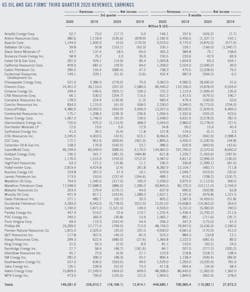Weak market environment weighs on third quarter results
A group of 54 US-based oil and gas producers and refiners posted a combined net loss of $18.17 billion in third-quarter 2020, compared to earnings of $12.81 billion in third-quarter 2019. Total revenues were $149.28 billion for the quarter, compared to $236.91 billion a year ago.
In the third quarter, travel restrictions and other limits on economic activities continued in many parts of the world to mitigate the spread of the COVID-19 virus. Although demand and commodity prices showed signs of recovery from second-quarter lows, they remained well below pre-pandemic levels, and challenges to oil and gas companies’ financial results persisted.
Brent crude oil prices averaged $42.96/bbl in third-quarter 2020, compared with $29.34/bbl in second-quarter 2020 and $61.93/bbl in third-quarter 2019. West Texas Intermediate (WTI) averaged $40.9/bbl in third-quarter 2020, compared with $27.81/bbl in second-quarter 2020, and $56.37/bbl in third-quarter 2019.
Since May, a recovery in oil prices to around $40/bbl has encouraged onshore operators to bring back some shut-in wells and large volumes of curtailed production were restored. Offshore, oil production from the Gulf of Mexico was impacted by Hurricane Laura and other tropical storms. About 1.6 million b/d, or 84%, of Gulf of Mexico production was shut down at one point in August.
US crude oil production averaged 10.93 million b/d for third-quarter 2020, compared to 10.81 million b/d for second-quarter 2020 and 12.24 million b/d for third-quarter 2019, according to the US Energy Information Administration.
The number of active oil rigs in the US declined to 183 at the end of September from 188 at the end of June, according to Baker Hughes. This also compared to 713 rigs at the end of September 2019. While the rig count was at a 15-year low, a record high inventory of drilled but uncompleted wells (DUCs) was supporting a boost in fracturing activity.
Meantime, US natural gas liquids (NGL) production continued to climb, as ethane extraction rose to record levels with the widening of the oil premium to natural gas prices. NGL production averaged 5.29 million b/d during the quarter, compared to 4.96 million b/d in second-quarter 2020 and 4.82 million b/d in third-quarter 2019.
US refining runs recovered from the lows seen in the second quarter but remained well below the prior year quarter due to planned maintenance activities and lower demand for transportation fuels because of the COVID-19 pandemic.
For third-quarter 2020, US refinery inputs were 14.52 million b/d, up from 13.65 million b/d in second-quarter 2020, but down from 17.42 million b/d for the third quarter a year ago. Refinery utilization rate was 78.3%, compared to 72.8% for second-quarter 2020 and 92.6% for third-quarter 2019.
According to Muse, Stancil & Co., refining cash margins in third-quarter 2020 averaged $4.85/bbl for Middle-West refiners, $6.02/bbl for West Coast refiners, $0.22/bbl for Gulf Coast refiners, $0.86/bbl for East Coast refiners. In the same quarter of the prior year, these refining margins were $16.29/bbl, $14.17/bbl, $7.04/bbl, and $4.38/bbl, respectively.
US commercial crude oil stock at the end of September was 493 million bbl, compared to 425.6 million bbl at the end of the same quarter a year ago and a 5-year average of 442.0 million bbl. Product stocks reached 926 million bbl at the end of the third quarter, compared to 920 million bbl at the end of second-quarter 2020 and 872 million bbl at the end of third-quarter 2019.
Natural gas prices at Henry Hub averaged $2/MMbtu in third-quarter 2020, compared with $2.38/MMbtu a year earlier. US marketed gas production averaged 97.87 bcfd, compared to 96.89 bcfd for second-quarter 2020 and 101.05 bcfd for third-quarter 2019, according to EIA.
US producers
ExxonMobil Corp. announced an estimated third quarter 2020 loss of $680 million, compared to net earnings of $3.17 billion for the prior year’s third quarter.
Third quarter capital and exploration expenditures were $4.1 billion, bringing year-to-date spending to $16.6 billion, more than $6 billion lower than the prior year period.
ExxonMobil’s oil-equivalent production for the third quarter was 3.7 million b/d, up 1% from second-quarter 2020. Excluding entitlement effects, divestments, and government mandates, liquids production increased 2%, while natural gas volumes decreased 1%.
Chevron Corp. reported a loss of $207 million for third-quarter 2020, compared with earnings of $2.6 billion in third-quarter 2019. Adjusted earnings of $201 million in third-quarter 2020 compares to adjusted earnings of $2.9 billion in third-quarter 2019.
Chevron’s worldwide net oil-equivalent production was 2.83 million b/d in third-quarter 2020, a decrease of 7% from a year ago. The decrease was largely a result of curtailed production in response to low commodity prices and asset sales, partially offset by net production increases at a number of properties.
The company’s US net oil-equivalent production of 982,000 b/d in third-quarter 2020 was up 48,000 b/d from a year earlier. International net oil-equivalent production of 1.85 million b/d in third-quarter 2020 decreased 247,000 b/d from third-quarter 2019.
The company’s acquisition of Noble Energy Inc. was completed in October following approval by Noble Energy shareholders (OGJ Online, July 20, 2020).
ConocoPhillips reported a third-quarter 2020 loss of $500 million, compared with third-quarter 2019 earnings of $3.1 billion. Excluding special items, third quarter adjusted earnings were a loss of $300 million, compared with third-quarter 2019 adjusted earnings of $900 million. Special items for the current quarter were primarily due to an unrealized loss on Cenovus Energy equity, partially offset by a favorable outcome from pending claims and settlements.
Production excluding Libya for third-quarter 2020 was 1.06 million boe/d. After adjusting for estimated curtailments of 90,000 boe/d and closed acquisitions and dispositions, third quarter production would have been 1.15 million boe/d, a decrease of 46,000 boe/d or 4% from the same period a year ago.
During the quarter, ConocoPhillips agreed to acquire Concho Resources in an all-stock transaction (OGJ Online, Oct. 19, 2020). The transaction is expected to close in first-quarter 2021.
Occidental Petroleum Corp. posted a net loss for third-quarter 2020 of $3.8 billion, and an adjusted loss of $783 million. Third quarter after-tax items affecting comparability included a write-down of $2.4 billion related to Occidental’s equity investment in Western Midstream Partners LP (WES) and $700 million of losses associated with the divestitures of onshore Colombia and mineral and surface acreage in Wyoming, Colorado, and Utah. Capital expenditure for the quarter, excluding discontinued Ghana operations, was $200 million.
Despite a disruptive domestic Gulf of Mexico storm season, Occidental’s total average daily global production of 1.24 million boe/d for the quarter exceeded the midpoint of guidance by 12,000 boe/d. Permian resources exceeded the high end of guidance by 3% with production of 420,000 boe/d. International average daily production volumes of 277,000 boe/d came in at the high end of guidance.
Occidental’s chemical pre-tax income of $178 million for the quarter compared to prior quarter income of $108 million. The improvement in third-quarter income resulted primarily from improved realized caustic soda and PVC prices, along with higher chlorovinyl sales volumes.
Marathon Oil Corp. reported a third-quarter 2020 net loss of $317 million, compared to net loss of $750 million for third-quarter 2019. The adjusted net loss was $219 million, compared to adjusted net loss of $477 million a year earlier. Capital expenditures for the quarter totaled $176 million.
Marathon’s total oil production for the quarter was 172,000 b/d and oil-equivalent production for the quarter was 370,000 boe/d.
Murphy Oil Corp. posted a net loss of $244 million. Adjusted net loss, which excludes discontinued operations and other one-off items, was $24 million.
The company’s third-quarter production averaged 153,000 boe/d with 56% oil and 63% liquids. Offshore production was negatively impacted by the hurricane season, resulting in 12,400 boe/d of storm-related downtime, compared to 4,800 boe/d as guided.
Storm downtime was partially offset by stronger performance in the onshore business. The North American onshore business produced 90,000 boe/d in the quarter. No operated drilling and completions activity is planned across the onshore business for the remainder of 2020.
Southwestern Energy Co. recorded a net loss for third-quarter 2020 of $593 million, including $361 million of non-cash impairments and a $289 million non-cash loss on unsettled mark-to-market derivatives due to rising prices in future periods. This compares to net income of $49 million in third-quarter 2019.
Adjusted net income, which excludes the non-cash items noted above, was $47 million in the quarter, compared to adjusted net income of $44 million for the prior year period, as decreased revenues due to lower prices were offset by decreased depreciation, depletion and amortization expense.
US independent refiners
Valero Energy reported a net loss attributable to stockholders of $464 million for third-quarter 2020, compared to net income of $609 million for third-quarter 2019. Adjusted net loss was $472 million for the third quarter, compared to third-quarter 2019 adjusted net income of $642 million. Third-quarter 2020 adjusted results primarily exclude the benefit from an after-tax lower of cost or market, or LCM, inventory valuation adjustment of $250 million and an after-tax loss of $218 million for an expected LIFO liquidation.
The refining segment reported a $629 million operating loss for third-quarter 2020 compared to operating income of $1.1 billion for third-quarter 2019. Excluding special items, third quarter adjusted operating loss was $575 million. Refinery throughput volumes averaged 2.5 million b/d in third-quarter 2020, which was 428,000 b/d lower than third-quarter 2019.
The renewable diesel segment reported $184 million of operating income for third-quarter 2020 compared to $65 million for third-quarter 2019. Renewable diesel sales volumes averaged 870,000 gallon per day (gpd) in third-quarter 2020, an increase of 232,000 gpd versus third-quarter 2019.
Phillips 66 announced a third-quarter 2020 loss of $799 million, compared with a loss of $141 million in second-quarter 2020. Excluding special items of $798 million in the third quarter, primarily an impairment related to the planned conversion of the San Francisco Refinery to a renewable fuels plant, the company had an adjusted loss of $1 million, compared with a second-quarter adjusted loss of $324 million.
Refining had an adjusted pre-tax loss of $970 million in third-quarter 2020, compared with an adjusted pre-tax loss of $867 million in second-quarter 2020. The decrease was largely driven by lower realized margins, partially offset by higher volumes. Phillips 66’s worldwide crude utilization rate was 77% in the third quarter, up from 75% in the second quarter. Realized margins were down 32% to $1.78/bbl in the third quarter, reflecting tightening crude spreads and lower secondary product margins.
Chemicals’ third-quarter 2020 pre-tax income was $231 million, compared with $42 million in second-quarter 2020. Chemicals results in the third quarter included a $101 million benefit to equity earnings from lower-of-cost-or-market inventory adjustments, partially offset by $2 million of hurricane-related costs.
Marathon Petroleum Corp. reported a net loss of $886 million for third-quarter 2020, compared with net income of $1.1 billion for third-quarter 2019. Adjusted net loss was $649 million for the third quarter 2020, compared with adjusted net income of $1.1 billion for third-quarter 2019.
Refining and Marketing (R&M) segment loss from operations was $1.6 billion in third-quarter 2020, compared with income of $989 million for third-quarter 2019. The decrease in R&M earnings was primarily due to reduced throughput, lower crack spreads, and weaker crude differentials. R&M margin, excluding the LIFO liquidation charge, was $8.28/bbl for third-quarter 2020, versus $15.11 for third-quarter 2019. Crude capacity utilization was 84% (excluding idled facilities) resulting in total throughput of 2.5 million b/d. Clean product yield was 85%.
Canadian firms
All financial figures are presented in Canadian dollars unless noted otherwise.
A sample of 11 oil and gas producers and pipeline companies with headquarters in Canada announced collective net loss of $4.8 billion in third-quarter 2020, compared to net income of $4.7 billion in the prior year’s third quarter.
Suncor’s net loss was $12 million in third-quarter 2020, compared to net earnings of $1.03 billion in the prior year quarter.
Suncor’s total upstream production was 616,200 boe/d during third-quarter 2020, compared to 762,300 boe/d in the prior year quarter. Synthetic crude oil (SCO) production decreased to 410,800 b/d in third-quarter 2020 from 479,300 b/d in third-quarter 2019. The upstream production decreased as the company experienced an operational incident at Oil Sands Base Plant and Fort Hills continued operating on one primary extraction train.
Refinery crude throughput was 399,700 b/d and refinery utilization was 87% in third-quarter 2020, compared to refinery crude throughput of 463,700 b/d and refinery utilization of 100% in the prior year quarter, with the decline due to the completion of the 8-week planned maintenance event at the Edmonton refinery and lower demand for refined products during third-quarter 2020. Refined product sales decreased in third-quarter 2020 to 534,000 b/d, compared to 572,000 b/d in the prior year quarter, as a result of the COVID-19 pandemic.
Imperial Oil recorded estimated earnings of $3 million in third-quarter 2020, up significantly from the prior quarter.
Upstream production for the third quarter averaged 365,000 boe/d, compared to 347,000 boe/d in second-quarter 2020. During the quarter, the company advanced and extended a planned turnaround at Kearl and experienced a 2-week outage of a third-party pipeline that supplies diluent to the site.
Downstream throughput averaged 341,000 b/d in the third quarter, with utilization at 81%, up from 278,000 b/d and 66% utilization in second-quarter 2020. Petroleum product sales for the third quarter increased to 449,000 b/d from 357,000 b/d in second-quarter 2020 due to improved product demand.
Canadian Natural Resources realized net earnings of $408 million and adjusted net earnings of $135 million in third-quarter 2020, a significant improvement over the second quarter levels. The increases in earnings are primarily a result of strong production volumes, continued reduction in operating cost levels, and improved commodity prices in the third quarter.
In third-quarter 2020, the company achieved quarterly production volumes of 1.11 million boe/d, including liquids production of 884,342 b/d which decreased as expected 5% and 4% from third-quarter 2019 and second-quarter 2020 levels, respectively. The decrease was due to the planned maintenance and turnaround activities in the Oil Sands Mining and Upgrading segment, primarily offset by strong thermal in situ production.

Conglin Xu | Managing Editor-Economics
Conglin Xu, Managing Editor-Economics, covers worldwide oil and gas market developments and macroeconomic factors, conducts analytical economic and financial research, generates estimates and forecasts, and compiles production and reserves statistics for Oil & Gas Journal. She joined OGJ in 2012 as Senior Economics Editor.
Xu holds a PhD in International Economics from the University of California at Santa Cruz. She was a Short-term Consultant at the World Bank and Summer Intern at the International Monetary Fund.

Laura Bell-Hammer | Statistics Editor
Laura Bell-Hammer has been the Statistics Editor for the Oil & Gas Journal since 1994. She was the Survey Editor for two years prior to her current position with OGJ. While working with OGJ, she also was a contributing editor for Oil & Gas Financial Journal. Before joining OGJ, she worked for Vintage Petroleum in Tulsa, gaining her oil and gas industry knowledge.

